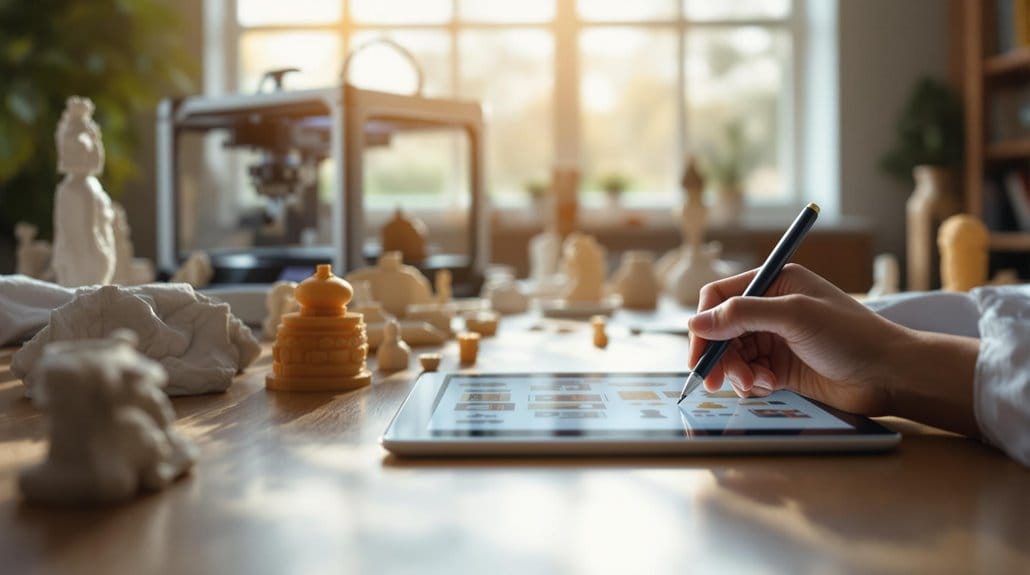You might not realize that technology can greatly enhance the way we approach cultural heritage conservation, transforming traditional methods into more efficient practices. By incorporating tools like 3D modeling and AI, you can not only preserve artifacts but also engage communities in meaningful ways. However, maneuvering this technological landscape requires strategic thinking and ethical considerations. Curious about how to effectively integrate these innovations into your conservation efforts? Keep exploring these five essential tips that could reshape your approach to preserving our shared history.
Key Takeaways
- Embrace digital documentation through technologies like laser scanning and photogrammetry to create precise 3D models of cultural sites.
- Utilize AI and robotics for advanced restoration, enabling accurate predictions and precise reassembly of fragmented artifacts.
- Foster community collaboration by engaging local residents in conservation efforts to enhance public awareness and ownership of cultural heritage.
- Implement advanced mapping techniques, such as LiDAR and UAV aerial mapping, to uncover hidden features and produce detailed 3D reconstructions.
- Ensure ethical standards by developing culturally sensitive AI systems and maintaining transparency in conservation practices for community involvement.
Embrace Digital Documentation
Embracing digital documentation transforms the way we preserve cultural heritage. By utilizing technologies like laser scanning and photogrammetry, you can create precise 3D models of cultural sites, enabling detailed analysis and effective preservation planning. This approach not only enhances the accuracy of your documentation but also safeguards historical records and artifacts for future research and educational purposes.
Take the Mogao Caves, for example. Their successful application of high-resolution scanning illustrates how digital documentation can protect ancient art from deterioration and environmental threats. By employing UAV-mounted sensors for aerial mapping, you can collect extensive data that improves the accuracy of preservation efforts and risk assessment.
Moreover, creating virtual exhibitions through digital documentation allows for wider public access to cultural heritage. This means you can engage with history in a meaningful way, without risking physical damage to the sites.
As you embrace digital documentation, you're not just preserving artifacts; you're fostering a sense of belonging and connection to our shared cultural heritage. By championing these innovative technologies, you contribute greatly to heritage conservation, ensuring that future generations can appreciate and learn from our past.
Utilize AI and Robotics
AI and robotics revolutionize the field of cultural heritage conservation by offering innovative solutions for the restoration and preservation of artifacts and sites. These technologies enhance traditional methods, enabling you to achieve results that were once beyond reach.
Here are some key benefits of utilizing AI and robotics in conservation:
- Advanced Restoration: Machine learning algorithms assist in predicting the original configurations of fragmented artifacts, ensuring accurate restoration.
- Precision Reassembly: Robotics allow for the physical reassembly of damaged cultural heritage objects with precision that manual methods may not achieve.
- Digital Preservation: High-tech scanning techniques create detailed digital replicas of artifacts, preserving their condition and ensuring accessibility for future studies.
- Non-destructive Analysis: Projects like Scan4Reco employ high-resolution 3D scanning to develop extensive digital records, enabling careful planning for restoration without damaging the original items.
Foster Community Collaboration
Fostering community collaboration in cultural heritage conservation transforms how we engage with and protect our shared history. By actively involving local communities in heritage preservation initiatives, you create a sense of ownership and pride, which enhances public awareness and support for conservation efforts. Collaborative projects harness local knowledge, leading to innovative solutions that improve preservation strategies.
Digital technology plays an essential role in this process. Utilizing online platforms for community engagement—like social media and virtual tours—can broaden your reach, allowing participation from those unable to visit heritage sites physically. These tools not only raise awareness but also invite diverse voices into the conversation.
Partnerships with educational institutions can further deepen community involvement. Students and educators can contribute to documentation and preservation projects, embedding cultural heritage into local curricula.
Additionally, organizing community workshops and events focused on cultural heritage education strengthens ties between residents and their heritage, fostering volunteerism and active participation in preservation activities.
Ultimately, community collaboration not only enriches the conservation process but also nurtures a collective identity, ensuring that the legacy of cultural heritage remains vibrant and relevant for future generations.
Implement Advanced Mapping Techniques
Advanced mapping techniques are revolutionizing the field of cultural heritage conservation by providing unprecedented detail and accuracy in documenting and preserving historical sites. By integrating technologies like LiDAR, GIS, and 3D modeling, you can enhance your preservation strategies effectively.
- LiDAR allows for precise measurement and elevation data, revealing features hidden from view.
- Aerial mapping with UAVs cuts costs and time, producing survey-grade maps and 3D reconstructions of heritage sites.
- GIS technology streamlines record-keeping and supports informed decision-making, enhancing fieldwork efficiency.
- Augmented reality applications create interactive experiences, enriching public engagement and education about cultural heritage.
These advanced techniques enable you to create a digital representation of heritage sites, facilitating meticulous documentation and restoration planning.
You'll find that 3D modeling not only maps out structures but also helps visualize potential restoration efforts.
Additionally, interactive experiences through augmented reality can draw communities closer to their cultural heritage, fostering a deeper understanding and appreciation.
As you implement these technologies, you're not only preserving the past but also creating pathways for future generations to connect with their cultural legacy.
Ensure Ethical Standards
Ensuring ethical standards in cultural heritage conservation is essential for maintaining integrity and respect in the preservation process.
As you integrate technology into conservation efforts, be mindful of the biases that can arise, particularly with AI models that often mirror dominant cultural perspectives. It's imperative to develop culturally sensitive AI systems that reflect diverse viewpoints.
Transparency is key; keep communities informed and actively involved in decisions about their cultural heritage.
Collaboration between technology experts and heritage professionals can help establish ethical guidelines that govern the use of digital tools, ensuring that historical narratives are presented fairly.
Prioritize open data policies to widen access to digitized collections, fostering public engagement while respecting cultural sensitivities and ownership.
This not only enhances community involvement but also promotes sustainable practices by embedding ethical considerations into every facet of your conservation efforts.
Funding initiatives should support projects that emphasize these ethical practices, reinforcing a commitment to inclusivity and respect for all cultural heritage.
Frequently Asked Questions
How Can Technology Be Used to Preserve Cultural Heritage?
You can leverage technology to preserve cultural heritage by employing 3D modeling and augmented reality to create interactive exhibits that engage the public.
Digital archiving and remote sensing enable detailed documentation and monitoring of heritage sites.
Mobile applications enhance accessibility, while data visualization tools help communicate important information effectively.
Social media platforms foster crowdsourced documentation, allowing communities to contribute to heritage conservation, ensuring that these cultural treasures are celebrated and remembered for future generations.
What Are the Heritage Conservation Techniques?
Imagine a world where every artifact whispers its story! You can employ a range of heritage conservation techniques, from meticulous restoration methods to innovative digital documentation.
Conservation materials play a vital role in site management, while archaeological techniques uncover hidden pasts. Emphasizing preventive conservation and collection care, you'll foster community involvement and heritage education.
How to Retain Our Cultural Language Using Technology?
To retain your cultural language using technology, explore language apps for interactive learning, and engage in online courses that enhance fluency.
Utilize multimedia archives and digital storytelling to preserve and share narratives. Social media connects you with global speakers, fostering community engagement.
Augmented reality can create immersive experiences to practice vocabulary in context. Translation software aids understanding, while virtual dialects and interactive archives guarantee your language thrives for future generations.
What Are the Challenges of Digital Preservation for Cultural Heritage Institutions?
When it rains, it pours, especially for cultural heritage institutions tackling digital preservation challenges.
You face digital obsolescence issues and data storage challenges, while funding limitations strain your resources. Staff training needs and metadata standards inconsistencies complicate your efforts.
Furthermore, access rights complexities and ethical considerations hinder user engagement strategies. Achieving long-term sustainability is tough with technological interoperability problems, but addressing these challenges is essential for preserving our shared cultural legacy.
Conclusion
In the grand tapestry of cultural heritage conservation, you might think it's all about dusty books and old artifacts. But really, it's about wielding technology like a superhero cape—embracing digital tools to save the day. So, why not trade in your paintbrush for a 3D scanner? After all, who wouldn't want to restore history with the precision of a robot while sipping ethically sourced coffee? Embrace the future, because those artifacts won't conserve themselves, and the robots are waiting!








